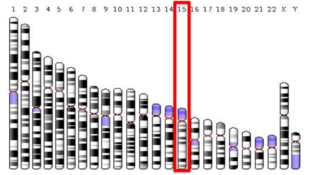
Platelet-derived growth factor receptor beta is a protein that in humans is encoded by the PDGFRB gene.

UPF0687 protein C20orf27 is a protein that in humans is encoded by the C20orf27 gene. It is expressed in the majority of the human tissues. One study on this protein revealed its role in regulating cell cycle, apoptosis, and tumorigenesis via promoting the activation of NFĸB pathway.

Transmembrane protein 229b is a protein that in humans is encoded by the TMEM229b gene.

QRICH1, also known as Glutamine-rich protein 1, is a protein that in humans is encoded by the QRICH1 gene. One notable feature of this protein is that it contains a Caspase Activation Recruitment Domain, also known as a CARD domain. As a result of having this domain, QRICH1 is believed to be involved in apoptotic, inflammatory, and host-immune response pathways.

CXorf26, also known as MGC874, is a well conserved human gene found on the plus strand of the short arm of the X chromosome. The exact function of the gene is poorly understood, but the polysaccharide biosynthesis domain that spans a major portion of the protein product, as well as the yeast homolog, YPL225, offer insights into its possible function.

Protein FAM214A, also known as protein family with sequence similarity 214, A (FAM214A) is a protein that, in humans, is encoded by the FAM214A gene. FAM214A is a gene with unknown function found at the q21.2-q21.3 locus on Chromosome 15 (human). The protein product of this gene has two conserved domains, one of unknown function (DUF4210) and another one called Chromosome_Seg. Although the function of the FAM214A protein is uncharacterized, both DUF4210 and Chromosome_Seg have been predicted to play a role in chromosome segregation during meiosis.

Transmembrane protein 134 is a protein encoded by the TMEM134 gene. TMEM134 does not have any other known aliases. There are two transmembrane domains and a domain of unknown function (DUF872). Evolutionary, the majority of the organisms that have this gene are primates and mammals, although there are some organisms dating back to Drosphila and C. elegans. Through current research, there has not been any confirmed function of TMEM134.

EVI5L is a protein that in humans is encoded by the EVI5L gene. EVI5L is a member of the Ras superfamily of monomeric guanine nucleotide-binding (G) proteins, and functions as a GTPase-activating protein (GAP) with a broad specificity. Measurement of in vitro Rab-GAP activity has shown that EVI5L has significant Rab2A- and Rab10-GAP activity.

Family with sequence similarity 63, member A is a protein that, in humans, is encoded by the FAM63A gene. It is located on the minus strand of chromosome 1 at locus 1q21.3.

Intermediate filament family orphan 1 is a protein that in humans is encoded by the IFFO1 gene. IFFO1 has uncharacterized function and a weight of 61.98 kDa. IFFO1 proteins play an important role in the cytoskeleton and the nuclear envelope of most eukaryotic cell types.
KIAA0753 is a protein that in humans is encoded by the gene KIAA0753. The gene is located on chromosome 17p13.1, on the reverse strand spanning bases 6578141 to 6641744. The KIAA0753 gene contains 18 exons, 19 introns, and has no known aliases.

C8orf48 is a protein that in humans is encoded by the C8orf48 gene. C8orf48 is a nuclear protein specifically predicted to be located in the nuclear lamina. C8orf48 has been found to interact with proteins that are involved in the regulation of various cellular responses like gene expression, protein secretion, cell proliferation, and inflammatory responses. This protein has been linked to breast cancer and papillary thyroid carcinoma.
Chromosome 12 Open Reading Frame 42 (C12orf42) is a protein-encoding gene in Homo sapiens.
Coiled-coil domain containing protein 180 (CCDC180) is a protein that in humans is encoded by the CCDC180 gene. This protein is known to localize to the nucleus and is thought to be involved in regulation of transcription as are many proteins containing coiled-coil domains. As it is expressed most highly in the testes and is regulated by SRY and SOX transcription factors, it could be involved in sex determination.
Transmembrane protein 254 is a transmembrane protein that is encoded by the TMEM254 gene, it is predicted to have many orthologs across eukaryotes.

C15orf39 is a protein that in humans is encoded by the Chromosome 15 open reading frame 15 (C15orf39) gene.

Tubulin epsilon and delta complex 2 (TEDC2), also known as Chromosome 16 open reading frame 59 (C16orf59), is a protein that in humans is encoded by the TEDC2 gene. Its NCBI accession number is NP_079384.2.

Chromosome 1 Opening Reading Frame 94 or C1orf94 is a protein in human coded by the C1orf94 gene. The function of this protein is still poorly understood.

Transmembrane protein 221 (TMEM221) is a protein that in humans is encoded by the TMEM221 gene. The function of TMEM221 is currently not well understood.

Transmembrane protein 247 is a multi-pass transmembrane protein of unknown function found in Homo sapiens encoded by the TMEM247 gene. Notable in the protein are two transmembrane regions near the c-terminus of the translated polypeptide. Transmembrane protein 247 has been found to be expressed almost entirely in the testes.

















